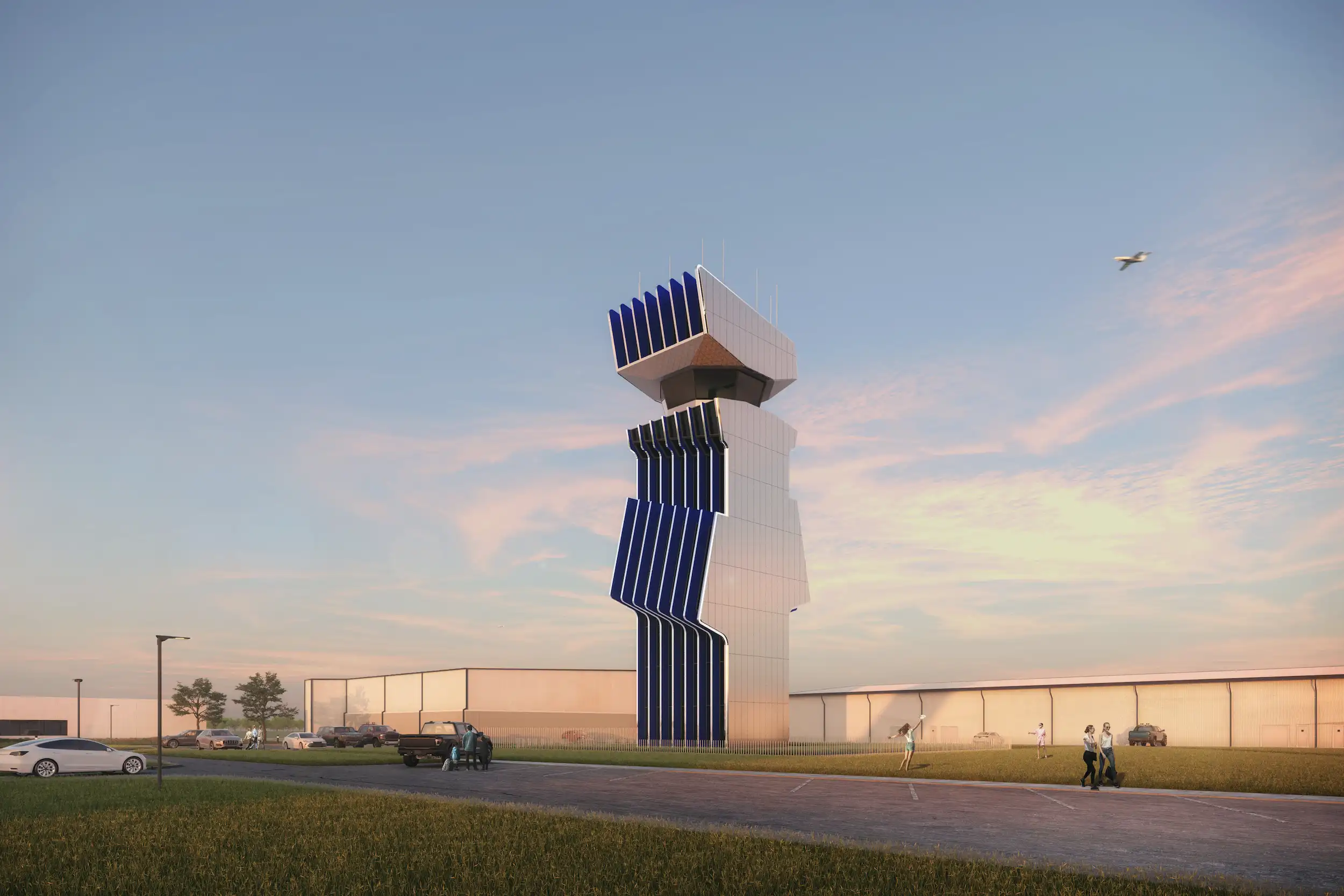Marlon Blackwell Architects Reveals Design for Air Traffic Control Tower in Columbus, Indiana

Rendering showing southeast perspective of the new Air Traffic Control Tower at Columbus Municipal Airport in Indiana. The project is expected to break ground next year. Image by Conica Studio, courtesy Marlon Blackwell Architects
Architects & Firms
Fayetteville, Arkansas–based Marlon Blackwell Architects (MBA) has shared its design for an air traffic control tower at Columbus Municipal Airport in Indiana that will replace an aging, 80-year-old tower that currently serves the two-runway facility—formerly a WWII airfield—located three miles north of the city. Rising above central Indiana’s pancake-flat landscape like a hibernating Transformer that might at any moment convert into a spacecraft, renderings of the design depict a steel- and aluminum-clad volume with a series of vertical fins rising from the ground to the sky along the glazed east and west elevations.
“What emerged from the design process was this idea of a kind of a shifting, silhouetted figure,” says MBA founder, 2020 AIA Gold Medalist Marlon Blackwell. “The inspiration was aerodynamics but without literally looking like a plane—something that shifted and undulated and spoke to mobility.”

The airport grounds are just north of downtown Columbus, next to the city's Ivy Tech Community College campus, which features a new main building by IwamotoScott. Image by Conica Design, courtesy Marlon Blackwell Architects,
MBA was announced as the winner of a competition seeking new designs for the tower late last year, beating out a shortlist of firms including Snow Kreilich, SO – IL, Höweler + Yoon, and studio:indigenous. Supported in part by the Cummins Foundation Architecture Program, the estimated $11.5 million project aims to bring the airport up to speed with the Federal Aviation Administration’s air traffic control design and safety standards with respect to sighting, backup cooling and power, security, and fire safety) while opening the larger site for greater non-aviation-related public use. Joining MBA are Woolpert (aviation design), Guy Nordenson Associates (structural design), Thornton Tomasetti (facade design), Threshold Acoustics (acoustic consulting), TM Light (lighting design), and Brian Payne, director of the Columbus Municipal Airport.
As relayed by Blackwell, the commission extends Columbus’s longstanding tradition of promoting design excellence while “extending it into something more infrastructural.”
“The tower has a civic presence but it’s also part of the infrastructure of the city,” says Blackwell, referring to his firm’s proposed design as “both a sentinel and beacon” that will serve as a vertical marker at the north of the city when approaching from the ground. Thanks to the largesse of hometown corporation Cummins (appropriately, a major engine manufacturer), the city is home to a trove of public buildings—churches, schools, libraries, fire stations, hospitals, recreational facilities, and on—designed by notable architects including I.M. Pei, Harry Weese, Kevin Roche, Gunnar Birkerts, Robert Venturi, Eero Saarinen, Cesar Pelli, and others. Blackwell—who has made his mark in and around another small but design-forward company town, Bentonville, Arkansas—joins contemporaries such as Deborah Berke, IwamotoScott, Carlos Jiménez, and Leers-Weinzapfel. (Columbus’s rich architectural heritage is the subject of a forthcoming book featuring images by RECORD contributing photographer Iwan Baan.)

1

2
Northwest (1) and southwest perspectives of the tower at dusk . Images by Conica Design, courtesy Marlon Blackwell Architects
With the glass-encased air traffic control center located toward the top of the 129-foot-tall tower (a boxy volume containing mechanical elements caps the structure—“we were trying to make that more expressive,” says Blackwell), below it is a breakroom and other dedicated areas for air traffic control staff along with a multi-purpose event space looking out and over the airport grounds. This space, explains Blackwell, will be open to community gatherings, private functions, and school group gatherings. “There’s the idea to make this an educational place, not just a place of work,” he says.
In addition to the potential for public programming within the tower itself, a large lawn located just to the south will be opened for events that will further draw people to this fast-developing area on the outskirts of town that’s home to the campuses of Ivy Tech Community College and Indiana University–Purdue University Columbus.




